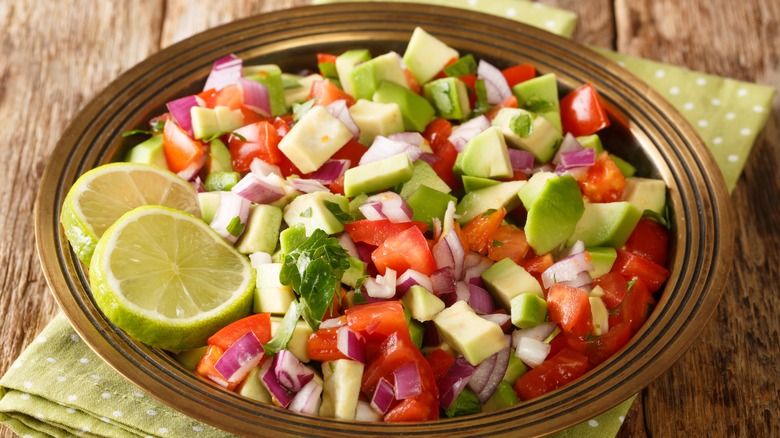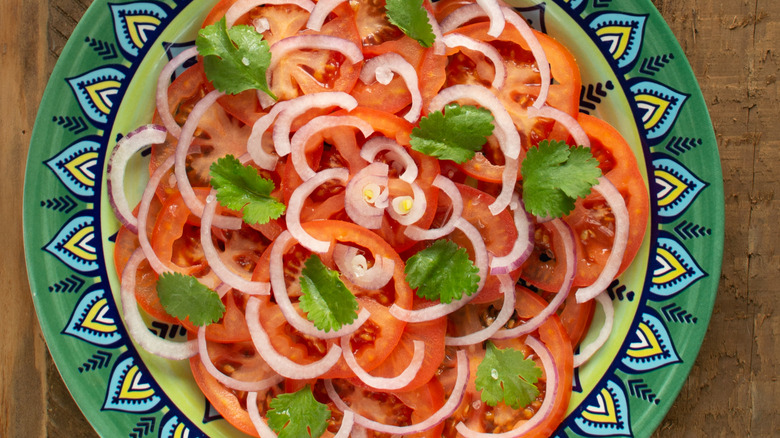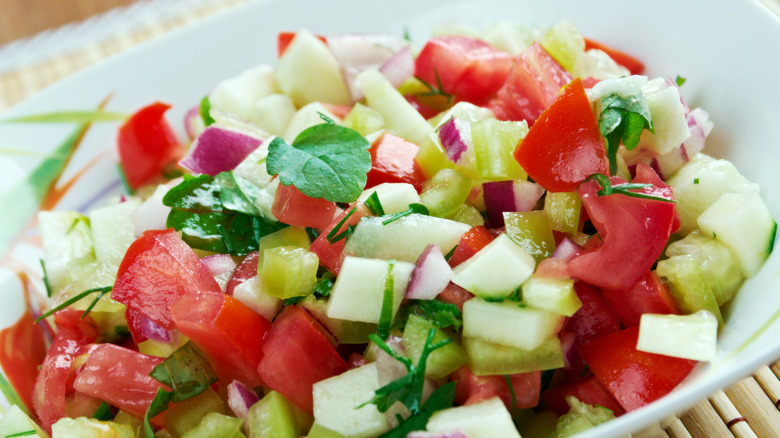Kachumbari Is The Kenyan Tomato Salad You Need To Know
Whether in a caprese salad or pico de gallo, chopped tomatoes deliver a refreshing hit. Although the fruit is believed to have originated in South America, it's no surprise that it's now enjoyed on every continent. With their balanced, slightly tangy flavor, tomatoes fit well into many dishes, including one particular staple out of Eastern Africa: The commonly enjoyed tomato salad known as kachumbari.
This popular salad produces a bold dose of flavor with only a handful of ingredients. Onions provide crisp, peppers some spice, and tomatoes comprise the base. Plus, a seasoning of citrus juice, salt, or sometimes alcohol is often added to tie it all together, much like with a salsa or an Iranian Shirazi salad.
Served as a side dish alongside meats and vegetables, the food brings a vibrant dose of an easy-to-love flavor. With a straightforward, chopped preparation, there's good reason why it's a ubiquitous staple in the region.
Background of kachumbari
Although most famously interlinked with Kenya, kachumbari is enjoyed across East Africa, including in Uganda, Rwanda, Tanzania, Burundi, and Malawi. Its name is Swahilli, likely deriving from the Indian salad cachumber.
As with other foods in Eastern African cuisine, there's an intertwining of South Asian techniques with local ingredients. In Malawi, where the dish is called shum, it's consumed on its own. However, elsewhere, it's a side — a refreshing bite amidst heartier fare. Most commonly, it's enjoyed alongside Nyama Choma, a barbecue-like affair of spiced roasted meats, including beef, pork, chicken, goat, and fish. And it's also a frequent accompaniment to ugali, a corn-based porridge that's a staple of East African cuisine.
In tracing to its Indian roots, kachumbari is often served alongside pilau. And like many African-style salsas, the quick-to-craft salad is a tableside condiment poised to deliver both refreshment and a dose of heat.
How is kachumbari made?
Tomato and onions are the core foundation of the salad. Unlike a salsa, the salad relies upon onions for texture with some renditions utilizing an entire bulb. If the vegetable delivers too much tang, it's soaked in cold water beforehand to curtail its bite. As for spice, Kachumbari incorporates the use of peppers. Most recipes use green, moderately spicy peppers like jalapeños. However, some craft a more intensely flavored version with bird's eye chilies. The juice of half a lemon or lime adds an acidic element, and the majority of renditions add cilantro and olive oil to tie it all together.
Since the salad retains a heterogeneous texture, the ingredients are coarsely chopped rather than finely diced. All the components are mixed together in a bowl and seasoned to taste. As a malleable foundation, there are many variations in additional components. Some add avocado or cucumber, while others incorporate fruits like mango and pineapple for a fruity twist. And for a bolder flavor, some chefs mix in a small serving of vodka or gin. Such is the delight of the salad — its taste is bright but won't overwhelm the entree.


